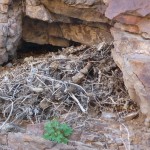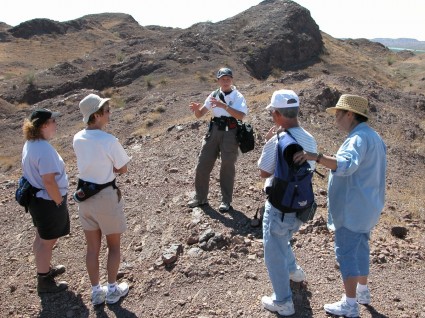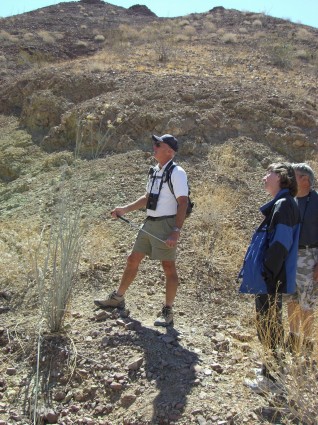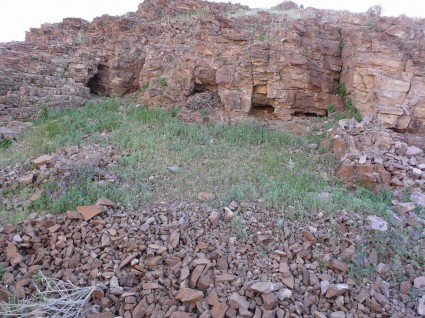A packrat den in a rock wall, stuffed with burro droppings, cactus pieces, and various vegetation, helps us explain to our winter visitors how we became involved volunteering with Denver’s Museum of Natural History.
We stop in front of this packrat midden during our desert hike at Imperial National Wildlife Refuge north of Yuma, Arizona, each Wednesday, as we lead 15 hikers up a wash and over burro trails in a region we call “B Wash.”

“Our packrat story begins with a hike we took years ago in the Pawnee Grasslands in northeastern Colorado,” we tell our hikers. “Chuck found a little jawbone that we couldn’t identify.”
Seeking Experts
When no one at the Denver Zoo could identify the jawbone, we took it to the Museum and left it for researchers to inspect. A few days later, the Museum called. “It’s the jawbone of a baby camel,” the caller said. “It’s 32 million years old.”
We learned two pieces of information from that call. First, we learned it’s illegal to pick up fossils on public lands (we didn’t know it was a fossil). And second, we learned that camels originated in North America 40 million years ago and migrated out 10,000-12,000 years ago. Fascinated by this information, we decided to become involved with the Museum in the paleontology department.
Cave Discovery
In summers, our work with the Museum brought us to a cave on a ranch in central Colorado where researchers were examining, recording, and collecting mammal fossils from the Pleistocene era, about 1.2 million years ago. The cave had been discovered in the late 1800s by miners who dug an entrance into what they hoped would be a mine. When they discovered the cave, they abandoned the area.

In the 1980s, Museum researchers explored the cave and discovered it to be a rich source of Pleistocene mammal fossils. Investigating further, they opened new rooms in the cave – rooms where no human had ever set foot. And in one of these rooms they found a Red Velvet tobacco tin.
Looking for a Note
“Let’s open it to see if there’s a note inside,” Kirk, one of the researchers, offered.
But the other researcher had other ideas. “Let’s go have lunch,” he said, and the two men left the cave.
After lunch, the researchers returned to explore further in the cave. When they once again came across the Red Velvet tobacco tin, Kirk couldn’t resist looking inside. When he opened the can, he actually found a note!
In primitive scrawl, the message read, “The one who finds this note, please drop us a line.” It was signed by Lloyd Marshall of Buena Vista, Colorado, and Elvis Conner of Nathrop, Colorado. The note was dated June 14, 1939.
Searching for Lloyd
Because the note was written just over 45 years before their discovery, Kirk thought perhaps one of these men could still be alive. After some investigation, he located Lloyd’s sister and learned that Lloyd Marshall was living in Oregon in the final stage of his life.
Kirk called Lloyd’s number in Oregon and asked to speak to Lloyd. He read the note to Lloyd over the phone. “Are you that Lloyd Marshall?” he asked finally.
The 71-year-old man on the other end of the line thought for a moment, then responded, “Yes, I am. That was in a Red Velvet tobacco can.”
Yes! Excited that he’d found his man, Kirk flew to Oregon to meet him in person and learn the history behind the note.
Story Behind the Note
Lloyd Marshall and his partner had been cowboys on a ranch in Colorado in the 1930s. One day as they rode to a rodeo, they stopped in front of a “mine” entrance to roll a smoke. After running out of tobacco, they were left with paper and the Red Velvet tobacco tin. Lloyd grabbed a pencil and wrote the note on the tobacco paper, folded it, slid it into the tin, and flung it into the mine entrance.
From there, a packrat lugged it into the far reaches of the cave never before explored by humans and left it where Museum researchers later discovered it.




